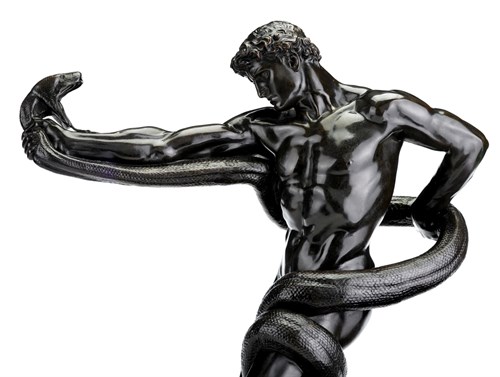January 25, 2011 10:00 EST
Fine English Furniture & Decorative Arts
143
Frederic, Lord Leigton P.R.A. (British, 1830-1896)
athlete wrestling with a python
Bronze, dark brown patina, modeled as a muscular athlete grasping a python at the throat as it coils around him, on a naturalistic base signed and dated "F. Leighton 1877" and inscribed 'Pubd. by Ernest Brown & Phillips, at the Leicester Galleries, Leicester Square, London", and numbered XIII, on marble plinth.
H: 22 1/2 in.
Provenance: Property of a Main Line Lady
Sold for $87,500
Estimated at $30,000 - $50,000
Bronze, dark brown patina, modeled as a muscular athlete grasping a python at the throat as it coils around him, on a naturalistic base signed and dated "F. Leighton 1877" and inscribed 'Pubd. by Ernest Brown & Phillips, at the Leicester Galleries, Leicester Square, London", and numbered XIII, on marble plinth.
Provenance: Property of a Main Line Lady
"This work was taken in its own time, and has been ever since, as a break-through in British Sculpture, and in particular as the harbinger of a movement called 'The New Sculpture'" (B. Read, Victorian Sculpture, New Haven and London, 1982, pp. 289-291).
Leighton's life-size bronze caused such a sensation at the RA when it was exhibited in 1877, the year before Leighton was made president, that it was immediately bought for the nation by the Chantrey Bequest, and subsequently won a gold medal at the Paris Exposition Universelle in 1878. The model for the figure in the sculpture was Angelo Colorossi, and the sculpture was executed in the studio of Thomas Brock, a successful sculptor and close friend of Leighton's. The bronze marked a new era for British sculpture, which moved away from staid neoclassicism and turned instead to the more energetic, naturalistic style of the 'New Sculpture' movement, influenced by Michelangelo, the Renaissance, and contemporary French sculpture. The composition, perhaps in no small measure inspired by the Laocoon (Vatican) and Titian's Bacchus and Ariadne (National Gallery, London), seems to have its foundation in the small clay models Leighton created in preparation for his painting The Daphnephoria, (Lady Lever Art Gallery, Port Sunlight), though the torsion and vigor in the current composition seems to have no counterpart in the serene, classically inspired painting.



